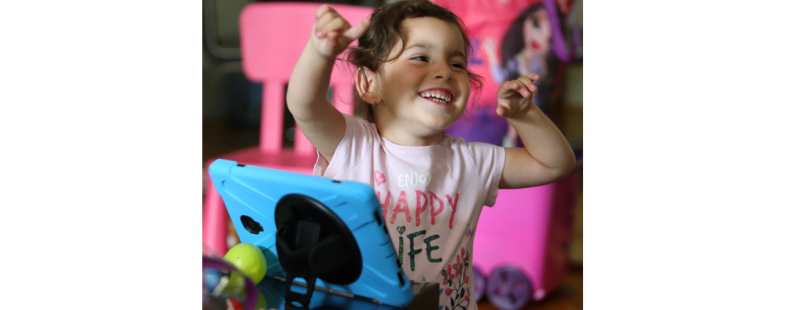Knowledge Base
Content
6a. Example - Serbia: Cboard successfully introduced to a 4 year old.
Updated by Global Symbols with UNICEF ECARO

A special educator and speech therapist describes the support given to a 4 year old girl who attended the Institute for Mental Health, Children's Day Hospital, Belgrade, Serbia
This YouTube Video shows Srna using Cboard (2.57 mins)
The young girl had delayed psychomotor development, as well as Struge Weber syndrome. She did not have any well developed showing/pointing or greeting gestures, did not understand simple tasks, and only recognized the word for water among other terms. She was occupied with exploring objects around her orally, biting and licking floor mats, objects, toys, and furniture.
After the diagnosis, counselling was offered to the parents to include the use of communication aids for further improvement and development of speech and language skills. The girl initially refused to use the communicator.
Her parents had not allowed her to use any screen-based technology until the assessment. She had not seen any cartoons, children's songs, etc. We helped to increase her motivation to engage with screen based technoloies by introducing a bubble app installed on the tablet screen. She could burst that symbol by touching the screen while she heard a sound that was fun for her.
Following these enticing activities, we introduced some initial symbols for the development of communication for those activities she enjoyed. We set up soap bubbles, a symbol to go outside, and a symbol to represent her mother. Together with the parents, we created opportunities for the girl to ask for soap bubbles through the communicator, and after a couple of weeks, the girl began to point to the balloon symbol without the support of her index finger. At the same time, a demonstration gesture was developed, which the girl began to use spontaneously.

Download Communication board for playing with soap bubbles (English PDF) (This can be translated by using Board Builder or CBoard)
This brought significant relief to the parents, because they did not always know exactly what the girl wanted to do. This caused anger attacks and crying. During those times, her parents found it hard to calm her, which made them extremely worried, because attacks of anger and anxiety were provoking factors that related to epilepsy attacks (an integral part of her clinical story).
As the weeks went by, the girl understood more symbols with support from her parents and daily use of the communicator. During enrollment at a kindergarten, they consulted with the educators and agreed use of the communicator in class.
Outbursts of anger were reduced, which parents saw as a significant improvement in social behaviour. After some time, the girl's interest in interacting with new items increased, she selected toys, played with sensory bottles, and with support, indicated that she wanted to have new toys. Her receptive language improved to the extent of understanding simple requests, she began to respond to her name and executing requests such as 'come', 'give', and 'sit'.
The parents continued to model spoken language with symbols on the communicator and slowly introduced some new symbols when their dauhter left the clinic. We continue with the provision of support and expanding communication.